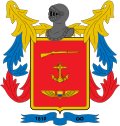This article needs additional citations for verification .(April 2020) |
| Cuerpo de Guardacostas de la Armada de Colombia | |
|---|---|
| Founded | 2 August 1979 (46 years) [1] |
| Country | |
| Type | Coast guard |
| Role | Admiralty law Maritime rescue Naval warfare |
| Size | 777 |
| Part of | Colombian Navy |
| Headquarters | Ministerio de Defensa Nacional, Bógota, D.C., Colombia |
| Motto(s) | Servir a la Humanidad Protegiendo la Vida en el Mar [2] |
| Colors | Red, Blue, Yellow> |
| Anniversaries | 2 August |
| Engagements | Colombian conflict |
| Website | www |
| Commanders | |
| Commander-in-Chief | |
| Commander of the Military | |
| Commandant of the Navy | |
| Commandant of the Caribbean | |
| Commandant of the Caribbean | |
| Insignia | |
| Jack |  |
| Jack |  |
| Pennant | |
The Colombian Coast Guard is the coastal defense, search and rescue, and maritime law enforcement branch of the Military Forces of Colombia. Equipped with modern electronic surveillance and location systems at land stations, the Coast Guard covers the Caribbean and Pacific coasts and focuses on the repression of crime at sea, the control of the preservation of the marine environment and search and rescue operations. [3]
Contents
The National Navy, through the Coast Guard, is a military maritime service which performs public safety and environmental functions, as well as protecting economic interests in the maritime areas under its jurisdiction, including the coasts, ports and internal waters of the country. Its characteristic mix of military capabilities, defense and support in humanitarian assistance operations, serves the country in five main functions, which are: sea safety, sea control, sea transit and MIOs. [4] [5]

